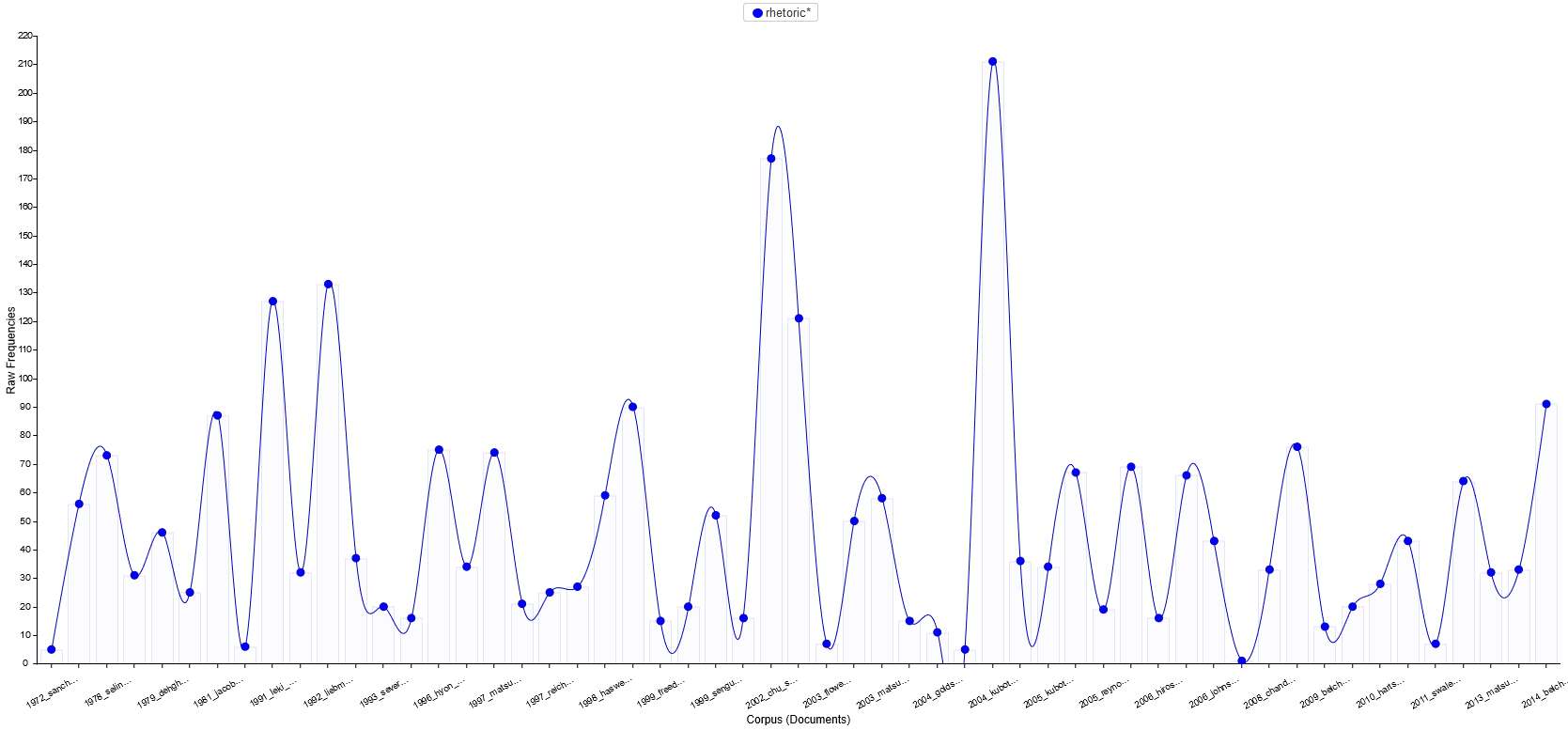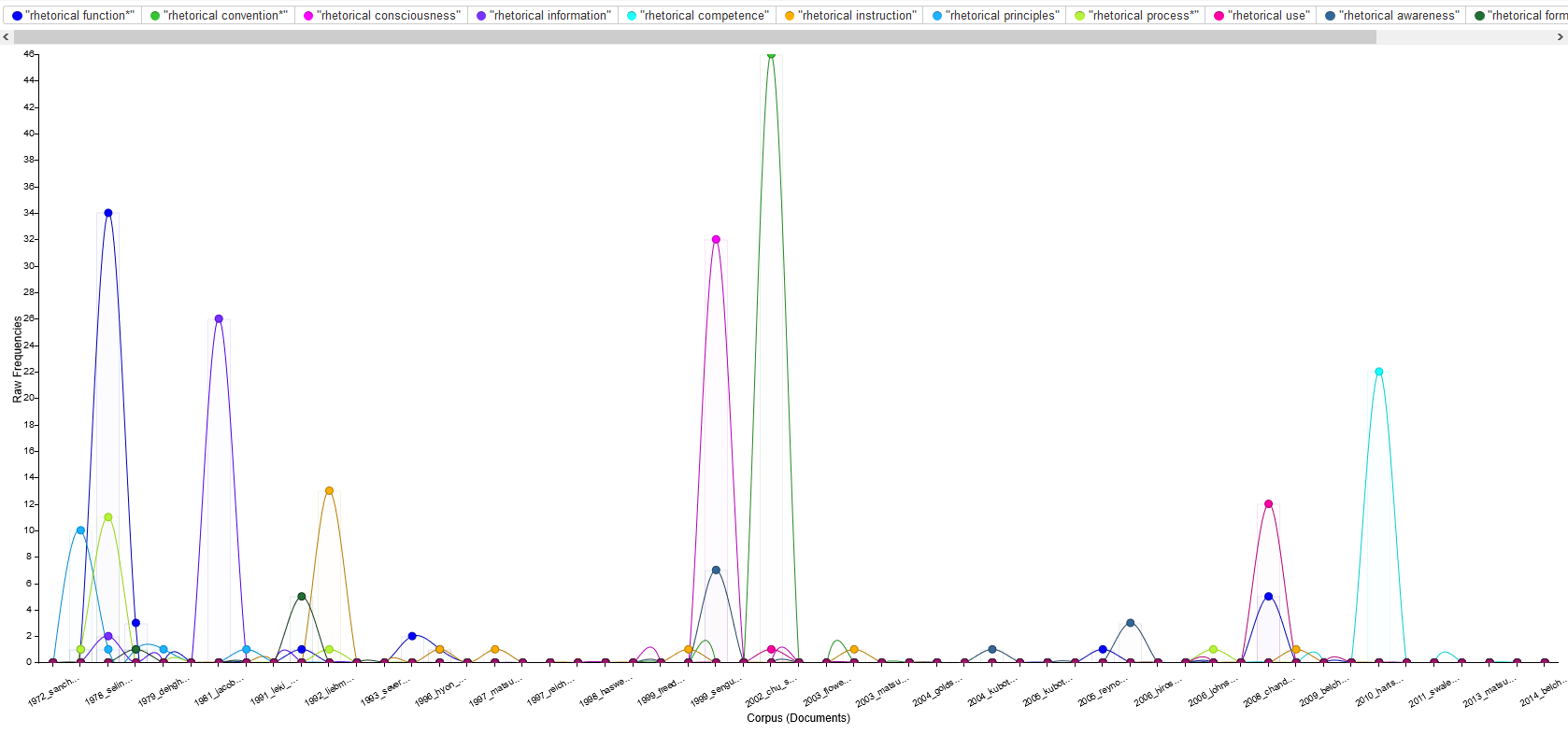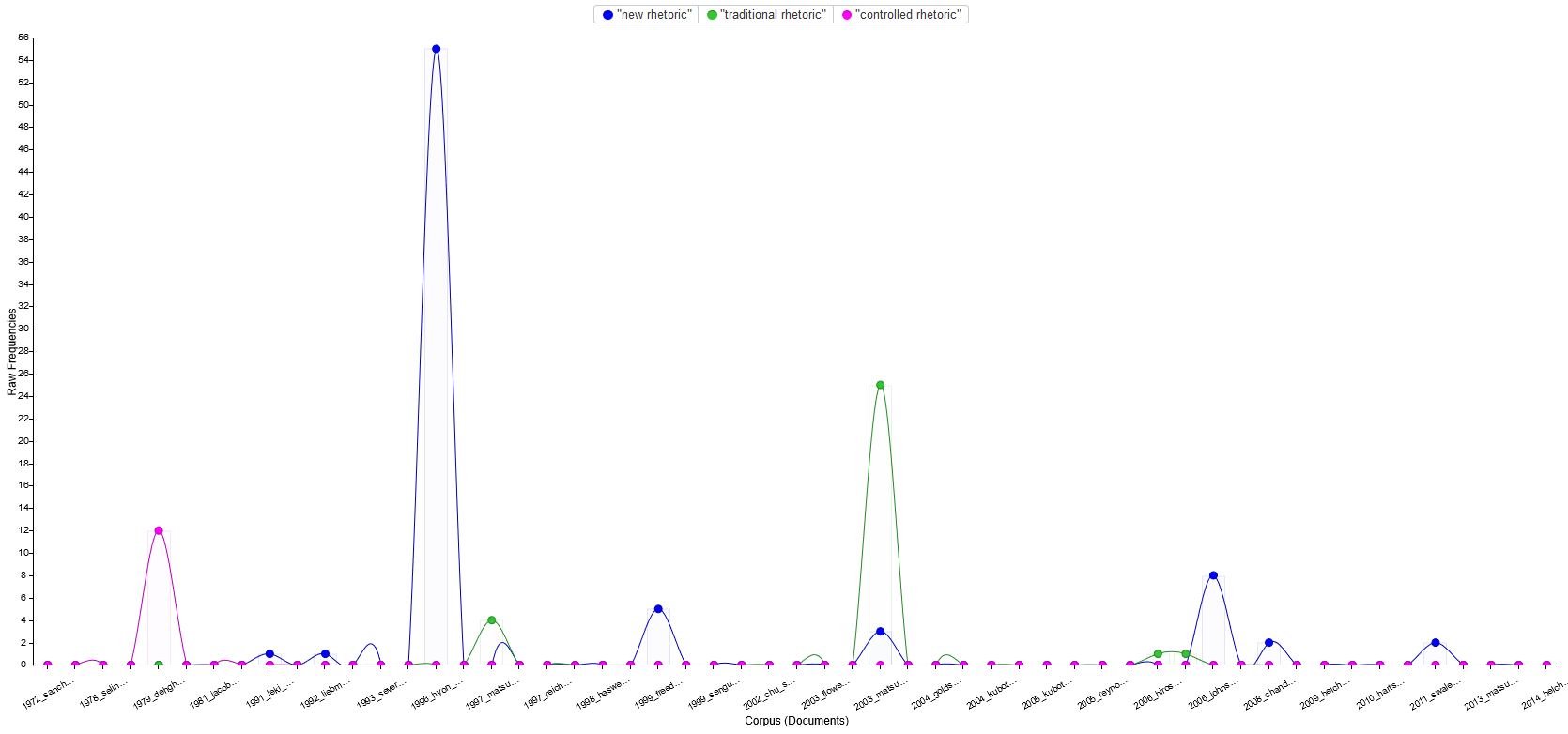Rhetoric's Outliers in Second Language Writing | Jay Jordan
Discussion
Ultimately, over the corpus' roughly forty two-year span, rhetoric names a collection of second language writing teaching approaches intended to be simultaneously heuristic, contextually responsive, pedagogically reducible, and replicable. Over 25 years ago, Ann Raimes (1991) discussed overlapping theoretical and pedagogical traditions in second language writing that represented the field's interdisciplinary development as well as its adherence to a strongly shared felt need for clear formal teaching targets. For Raimes, the best outcome of such an overlap was the lack of a "single new approach" (p. 423), which she read as a hopeful signal that her colleagues understood composition's irreducible complexity. To be sure, complexity emerges in the findings of scholars whose work is captured in this limited corpus. "Rhetoric" appears frequently and consistently—on average, 48 times per article. At the same time, its appearance and its clustering with other terms is highly variable: the average of 48 spans a range from 1 to 211 occurrences per article (Figure 1).
 Figure 1: Voyant Tools chart showing instances of "rhetoric*" per article in corpus with chronological trend.
Figure 1: Voyant Tools chart showing instances of "rhetoric*" per article in corpus with chronological trend.
And again, as my focus on "outliers" in this webtext demonstrates, "rhetoric" and "rhetorical" cluster with numerous terms that seem to erupt in specific articles/at specific times with few if any other appearances. "Rhetorical function," for instance, is explicitly relevant to early 1970s attempts to articulate formal pedagogies for English for Science and Technology. And the overwhelming majority of mentions of "new rhetoric" appears in an article that reviews strands of genre-based pedagogy in the field, among which new rhetoric approaches are the least popular and thus least represented elsewhere in the corpus. (See Figures 2 and 3.)
 Figure 2: Voyant Tools chart showing bigrams with "rhetorical" per article in corpus with chronological trend.
Figure 2: Voyant Tools chart showing bigrams with "rhetorical" per article in corpus with chronological trend.
 Figure 3: Voyant Tools chart showing bigrams with "rhetoric" in right position per article in corpus with chronological trend.
Figure 3: Voyant Tools chart showing bigrams with "rhetoric" in right position per article in corpus with chronological trend.
Despite the terminological eruptions in the corpus, though, closer reading of relevant articles reveals consistent themes in the field's implicit definitions and applications of "rhetoric." While the phrase "controlled rhetoric" appears in only one article in the corpus (Dehghanpisheh, 1979), pedagogical imperatives to control students' rhetorical work are consistent throughout—whether in traditional modal terms (such as exposition), as Dehghanpisheh suggests; in organizational terms, as in EST-influenced pedagogies in the 1970s or as in Suzanne E. Jacobs' (1981) expression of academic expectations about cohesion; or in emphasizing accuracy over rhetorical competence altogether, as in K. James Hartshorn et al. (2010).
To be sure, similar historical study of L1-focused composition literature would reveal some themes and preoccupations similar to those I have identified in this L2-focused corpus. But consistent concerns about L2 writers' backgrounds, proficiencies, and competencies appear to inform claims about students and suggestions for pedagogy in very L2-specific ways. As I related, I excluded "contrastive rhetoric" and the closely related "intercultural rhetoric" in order to expand my view of rhetoric's circulation in the field, so CR's emphasis on students' putative first-language "rhetorics" is not as apparent in my analysis. But it is still very relevant. Jacobs (1981) claimed a "cultural explanation" for what she reads as nonnative English writers' failure to create the dense cohesive connections necessary to US-centric academic prose (p. 245). Hsi–Chin Janet Chu, Janet Swaffar, and Davida H. Charney (2002) stopped short of asserting that there are rigidly prescribed "Chinese" rhetorical forms to which Chinese-speaking students will reliably adhere, but they went on to point to a macrostructural cultural "essence" within a range of student texts (p. 514).
To address mismatches between such culturally grounded rhetorics and preferred English-language targets, scholar–teachers in the corpus suggest pedagogies predicated on the idea that "rhetoric" names very stable forms and practices. John Lackstrom, Larry Selinker, and Louis Trimble (1973) defined EST rhetoric as a hierarchically nested collection of textual choices ranging from genre to verb tense—a collection that provides ready-made formal goals for teaching that Larry, Selinker, Mary Todd-Trimble,and Louis Trimble (1978) revisited and attempted to refine. For Sunny Hyon (1996), second-language writing instruction was nearly synonymous with explicit targets grounded in specific theories of genre other than New Rhetoric, which means that New Rhetoric's rich cross-community approach does not seem sufficiently schooling-focused. And even though JoAnne Liebman (1992) did suggest a need for rich conceptions of rhetoric in the field, she clearly circumscribed rhetoric as a classroom subject—one that builds on prior grammar knowledge, which, in a student's first language, is acquirable at home and in other informal settings, but acquisition really begins with formal education.
A challenge, though, for L2 writing's insistence on rhetoric as a formal collection of school-based targets is that a text's rhetorical effectiveness often exceeds explicit and readily teachable linguistic forms. Selinker et al. (1978) recognized that their carefully crafted model of EST discourse, which among other features delineated "example," "illustration," "definition," and other discrete functional categories, broke down in actual examples of published EST writing. So while their students could readily identify unambiguous instances of a rhetorical function, the students found it difficult to analyze instances of mixed functions, especially where a single paragraph included several of them. Jacobs (1981) expressed frustration that many cohesive strategies essential to meaning-making are effective precisely because they are implicit, and thus difficult to teach directly. Sima Sengupta's (1999) more student-generated analytical scheme for texts' reader friendliness broke down similarly at the point where students shifted from reading to their own writing—thus showing a gap between the declarative rhetorical awareness of clear textual features on one hand and procedural rhetorical competence on the other. In order to teach rhetoric to L2 students, it seems, "rhetoric" must be bounded. And it must be schooled, not just broadly pedagogical.
Precisely describable organizational principles may be a holy grail of L2 rhetoric pedagogy, but they remain as elusive. As Robert Kaplan (1966) himself noted about the doodles, rhetoric's teaching value is ultimately heuristic. But where some scholar–teachers in Kaplan's tradition may have wanted to believe that contrastive teaching could proceed from clear L1 product to clear L2 product, empirical research throughout even my limited corpus has consistently demonstrated that those products evade much direct teaching, no matter how controlled the context.